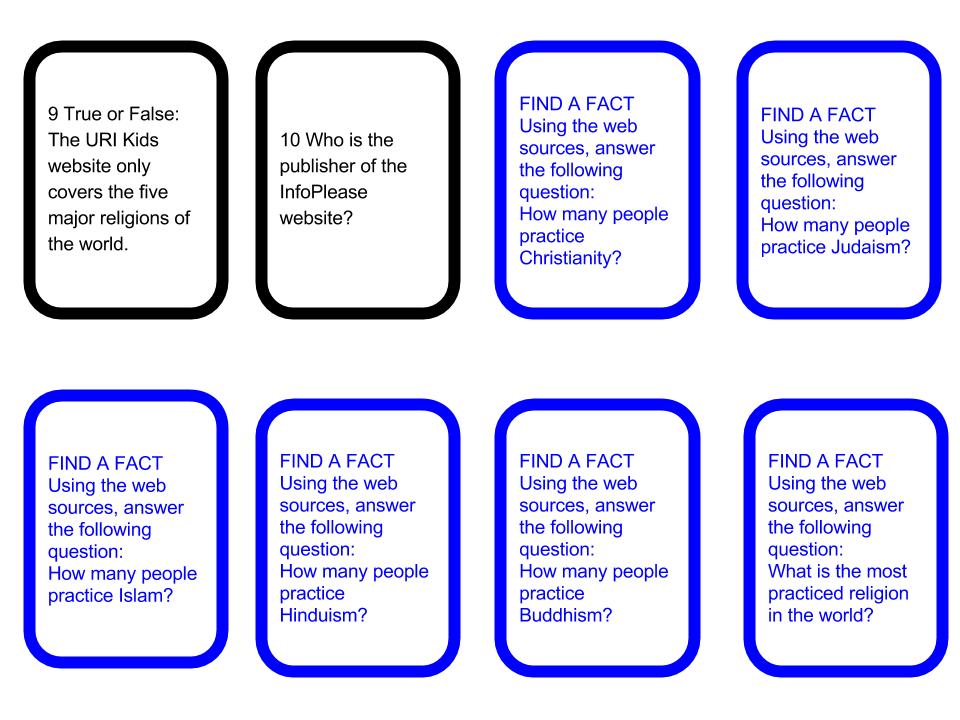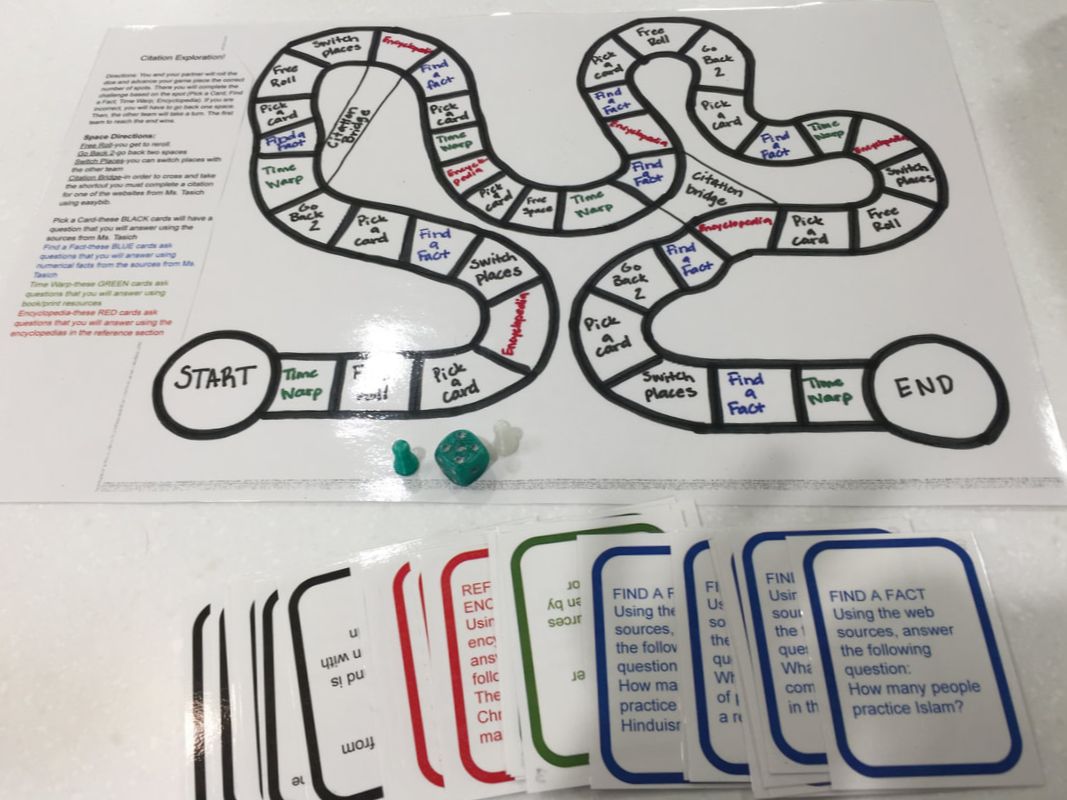|
Before reading this post, make sure to check out Post 1 (info to get started) and Post 2 (the process) on Research and Gamification.
After stepping back from this process and taking time to think about what worked and what didn't, I have three things that I consider to be important pieces of advice: 1. Try out the games first! While this seems obvious, gamification is NOT something that you can throw together in the morning and just hope that everything works. While I am usually a pretty easy going lesson planner, for these types of lessons and activities, I made sure to prep all of my materials and links beforehand. This way I could have the other teachers I was working with check out the games and links to make sure all of my settings were correct and valid. I had to change the permissions on one google document, change the heading on a form, and had to reword one of the game card questions. All small items, but things that were good to get fixed before the day of the lesson. 2. Be ready for some noise/movement in the classroom. Again, this might seem obvious, but if you are a TL working with a classroom teacher, or someone who is used to having a "quiet" classroom, keep in mind that the collaborative and fun nature of these games and activities will lead to children talking. This is not a bad thing, but something to be prepared for mentally. 3. Don't worry if something goes wrong. No matter how much preplanning you do, or how many times you and another staff member go through the game, there will still be some things that are "off" or not working on the day you do the activity. Don't panic! Let the kids try to figure out the problems on their own, and remember that productive frustration can be just as enlightening as the traditional curriculum you are teaching. I'd love to hear how you use this type of activity in your classroom/library space!
0 Comments
For more information, or to see WHY I decided to try gamification, along with some resources, check out Part 1 of this series. Today's post will cover the actual process I went through in making the games. I created a digital breakout for the 8th graders and a traditional board game for the 7th graders. The 8th graders instruction was focused on evaluating sources since they were going to be finding research on their own. We went over databases and keywords and the digital breakout had topics focusing on comparing two sources (database result and web result), determining if something is fake news, setting parameters on advanced searches, and finding information on an author of a website. These skills were all things that I had noticed the students struggling with on past research projects. When I first started with this project, I wanted to do an escape room of sorts with QR codes and stations around the room. I initially planned on having kids use the iPads to scan the codes and fill in the Google Form, but after looking into it and realizing the split screen option wouldn't work as well as I wanted it to, I switched and decided on a digital breakout utilizing Google Sites. To begin, I created a folder for each of the different stations/projects. These stations became different pages/tabs on the actual site itself. In each folder I put the Google Form for that page, the links I used, copies of PDFs, and any other info (pictures, sites, etc). Each page had a Google Form that asked questions relating to the material on that topic, and the submission screen on each Form gave a color code. This color code was used on the home page of the Site to unlock the final problem and "win" the game. HERE is the Google Site I created for this project (the overall storyline/theme was alien invasion). The 7th graders were using information we gave them (a collection of web sources, print materials, and encyclopedias found in the library) so they didn't need as much instruction on source evaluation. Rather, their lessons focused on using the materials provided and creating citations. For them, I created a board game. Before creation, I knew that I wanted them to have to answer a variety of question types, and solve a few "challenges." I used a template I found online (pictured below) and blew it up on the school's printer to fit an 11X17 piece of paper. After I printed one, I outlined the squares to make it darker and filled in the different spots. I had already decided on four different types of questions: Find a Fact, Pick a Card, Time Warp, and Reference. Each type of question had a deck of cards I made that had questions specific to it. Time Warp questions used printed materials, Reference used the encyclopedias, Find a Fact and Pick a Card both used the web resources we had curated for them. I created the game cards using Google Draw (see example below). Finally, the tech guy and I used the 3D printer to create dice and game pieces (in two colors) for each board game set. In the end we made enough for 6 games to be going at once, which equals out to about 4-5 people per game (2 teams). Below is a pic of a completed game set: For both games (the digital and the traditional) the hardest thing was coming up with what all I wanted them to get out of the game FIRST and then working backwards. This was not a project that you could complete the morning of, or do with just a random thought. There was a lot of planning involved, and I was glad to be able to create this for teachers. Working in the library gives me more flexibility in planning, so I am able to create projects like this more easily than a classroom teacher can on their own.
Part 3 of this series will deal with my thoughts AFTER the games were done and how the students responded. Stay tuned! This is the first post in a three part series about how I used gamification to teach/reinforce research skills in the library. This post will cover how I began, the process for gamification, and some additional sources on game-based learning and gamification. Part 2 will cover the actual creation of the games (a digital breakout and a traditional board game). Part 3 will cover how it went along with my reflections from the experience.
I had two teachers (7th grade Social Studies and 8th grade English) recently approach me about teaching research at the beginning of two different projects. The 7th graders were doing a unit on World Religions and the kids were going to create a poster/infographic with the information they found. The 8th graders were starting a unit on persuasion. They had already come in for an overview of using the library databases and the library website. They were getting ready to find sources on their own now. For both of these units, I knew I wanted to do something besides just lecture and showing websites/sources. They each had different end goals, especially considering the fact that the 7th graders were using sources we had already given them. Their instruction needed to focus on utilizing those sources and creating citations. The 8th graders were going to be searching on their own, so they needed to know how to evaluate the information they found. I decided to do a gamification of the information. For the 7th grades I wanted to create a traditional board game. For the 8th graders I wanted to have a digital breakout or escape room. With this in mind, I started searching for other sources/teachers/examples. The hardest thing about gamification or creating game-based learning opportunities in understanding how it is going to look at the end. This is definitely a time where you need to plan out what you want and work backwards. Some sources to consider: How to Gamify Your Classroom How to be as entertaining as a video game The Ultimate Guide to Gamification Digital Breakout Templates Breakout EDU-digital |
Amy Tasich archives
January 2021
Categories
All
|



 RSS Feed
RSS Feed
